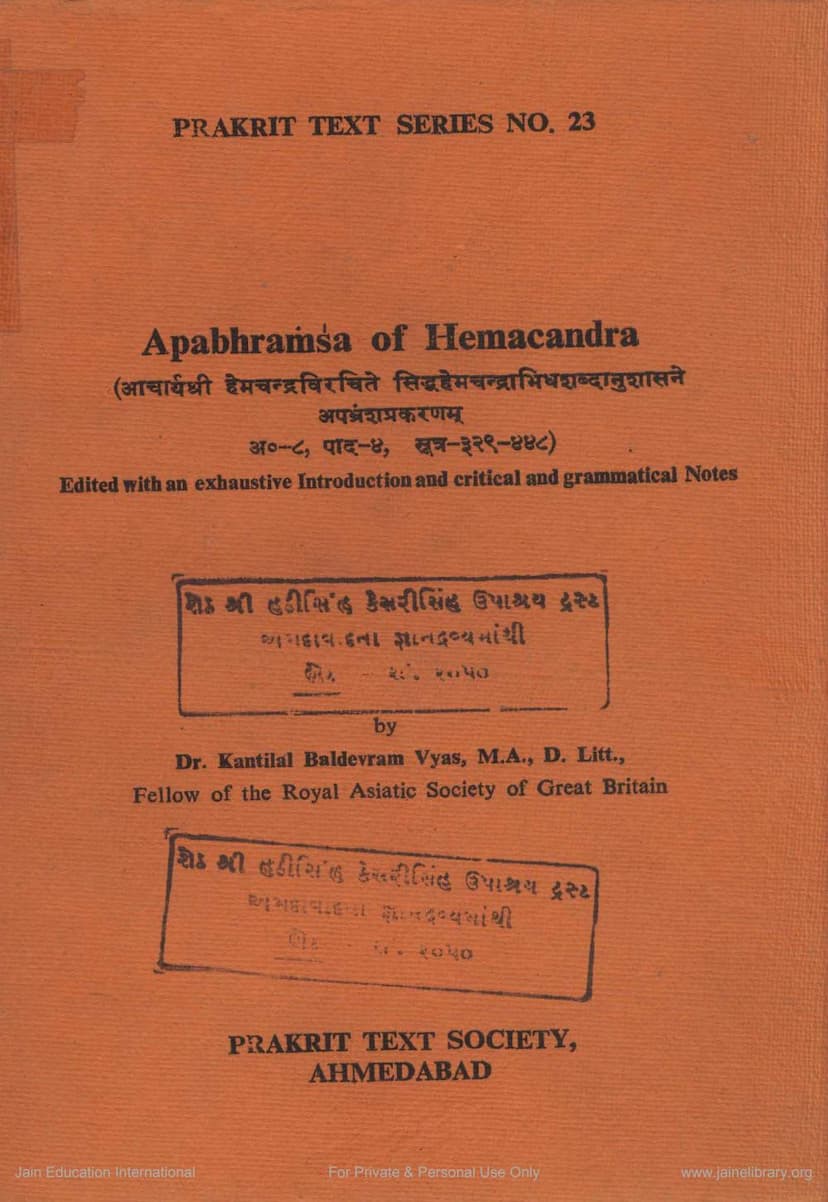Apbhramsa Of Hemchandracharya
Added to library: September 1, 2025

Summary
This document is a scholarly edition of the Apabhramśa Prakaraṇa (the section on Apabhramśa) from Acharya Hemachandracharya's renowned Sanskrit and Prakrit grammar, the Siddhahemachabdānusāsana. Specifically, it covers Chapter 8, Part 4, Sutras 329-448.
Here's a comprehensive summary of the provided text, focusing on its content and context:
1. Title and Authorship:
- Book Title: Apabhramśa of Hemchandracharya
- Author: Acharya Hemachandracharya (the original author of the grammar)
- Editors/Compilers: Kantilal Baldevram Vyas, Dalsukh Malvania, H. C. Bhayani (Dr. Vyas is credited with the editing, Introduction, and Notes)
- Publisher: Prakrit Text Society, Ahmedabad
- Series: Prakrit Text Series No. 23
- Publication Date: 1st Edition, 1982
2. Purpose and Significance of the Work: The General Editor's Foreword highlights the immense importance of this Apabhramśa section of Hemachandracharya's grammar. Apabhramśa is presented as the fountain-head from which modern Indo-Aryan languages like Gujarati, Rajasthani, and Western Hindi emerged. Its morphology, including nominal and verbal terminations, and its vocabulary are directly descended from Apabhramśa. The text is considered "almost the one and only available classical grammar of Apabhramśa."
3. Introduction by Dr. K. B. Vyas: The Introduction delves into several key aspects:
- Importance of Apabhramśa: It underscores the foundational role of Apabhramśa in the evolution of Western Indian New Indo-Aryan languages.
- Linguistic Features: Apabhramśa is described as a Middle Indo-Aryan/Prakrit speech that developed unique phonetic features (like OIA retention, vowel shortening, nasalization, spirant reduction to aspiration) and significant morphological changes, necessitating the use of postpositions.
- Literary Legacy: Beyond linguistic structures, Apabhramśa influenced the literary forms, metrics, and rhetorical nuances of later languages.
- Hemachandracharya's Grammar: The Siddhahemachabdānusāsana is presented as the primary source for understanding Apabhramśa as a popular speech, written in the traditional Pāṇinian style. The eighth chapter details Prakrit grammar, with the final part focusing on Apabhramśa (Sutras 329-446), providing numerous illustrations.
- Historical Evolution of the Term "Apabhramśa": The term's connotation changed over time, initially referring to deviations from Sanskrit, then evolving to denote a distinct literary language of tribes like the Gurjaras and Abhiras.
- Dialectal Variations: The Introduction discusses the debate around multiple Apabhramśa dialects. It argues against this hypothesis, citing the linguistic uniformity in literary works and Hemachandracharya's unified treatment. Western scholars like Grierson and Chatterjee are mentioned as proponents of the multiple-dialect theory, while scholars like Madhusudan Modi and H. C. Bhayani support the single-language view, emphasizing its Western Indian provenance.
- Historical Anecdote of Composition: A significant historical anecdote is recounted about the inspiration for Hemachandracharya's grammar. King Siddharāja Jayasimha, impressed by works from Malwa, requested a similar comprehensive grammar for Gujarat. Hemachandracharya, with royal support, produced the Siddhahemachabdānusāsana, which bears the king's name.
- Manuscript Basis: Dr. Vyas explains his use of several important old manuscripts (mss. A, B, C, D) obtained from Patan's Jñāna Bhandāras, which he considers close descendants of Hemachandracharya's autograph copy. Manuscript A, copied by Pratiṣṭhāsomagaṇi in V.S. 1492, is highlighted as the primary source.
- Editorial Scheme: The notes accompanying the text provide detailed explanations, Sanskrit chāyā of Apabhramśa verses, interpretations by various scholars, significance of illustrations, and analysis of meters.
4. Contents of the Apabhramśa Grammar (Sūtras 329-448): The Introduction outlines the categories covered by Hemachandracharya in his Apabhramśa grammar:
- Phonology: Sutras 329, 396-399, 410-412.
- Nominal Declensions: Sutras 330-354.
- Feminine Stem Formation: Sutras 400, 431-433.
- Pronominal Declensions: Sutras 355-381.
- Verbal Formations: Sutras 382-389, 438-442.
- Verbal Substitutions: Sutras 390-395.
- Adverbs, Postpositions, etc.: Sutras 401, 404-406, 414-420, 423, 428, 436, 444.
- Other Substitutions: Sutras 402, 403, 407-409, 413, 421, 422, 435.
- Word Formation: Sutras 429-430, 434, 437, 443.
- Gender Irregularities: Sutra 445.
- Saurasenisms: Sutra 446.
- Dialectal Interchanges & Tense Usage: Sutra 447.
- Sanskrit Words in Prakrit: Sutra 448.
5. The Text (Sutras and Examples): The bulk of the document (Pages 30-76) presents the actual Apabhramśa text of the sutras, followed by:
- Apabhramśa verses (illustrations): These provide examples of the grammatical rules described in the sutras.
- Sanskrit Chāyā: A Sanskrit rendering of the Apabhramśa verses.
- English Translation: A translation of the verses.
- Notes: Detailed explanations of the sutras, grammatical peculiarities of the words used in the verses, discussions of meter, and references to scholarly interpretations (Pischel, Alsdorf, De Vreese, Vaidya, Bhayani).
6. Appendices:
- Notes: Detailed scholarly notes explaining each sutra and its accompanying verse.
- Dodhaka Vrtti: A commentary on the Apabhramśa verses.
- Index (Shabd-suchi): An extensive index of Apabhramśa words with their Sanskrit equivalents and sūtra references.
- Prashasti: A eulogy for King Mularaja and King Jayasimhadeva, the patrons of Hemachandracharya.
In essence, this publication is a critical edition of a foundational text for the study of Apabhramśa and the early development of North Indian languages. It combines the original Apabhramśa text with scholarly apparatus designed to make this complex linguistic material accessible to students and researchers.